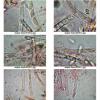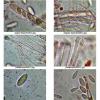
20-12-2025 23:08
Patrice TANCHAUDBonsoir, récolte sur sol sablonneux dans l'arri�

21-12-2025 09:32
Hello.A tiny ascomycete found embedded in wood in

20-12-2025 15:47
Mirek GrycHi.These grew on pine wood that was heavily covere

18-12-2025 21:17
Pol DebaenstThe identification took me to Byssonectria deformi

15-12-2025 07:09
 Danny Newman
Danny Newman
indet. Rutstroemiaceae sp. on unk. fallen leavesMc

19-12-2025 10:10
Patrice TANCHAUDBonjour, récolte réalisée en milieu dunaire, a

18-12-2025 17:23
 Bruno Coué
Bruno Coué
Bonjour,je serais heureux d'avoir votre avis sur c

18-12-2025 18:07
Margot en Geert VullingsThese plumes were found on rotten wood.They strong
 Bonsoir à tous,
Bonsoir à tous,Pouvez-vous me donner une piste pour ce Ciborinia greffé sur sclérote noir en forme de banane, trouvé en aulnaie à ail des ours dans un mélange de matière organique (feuilles) pourrissantes et terre mêlée ?
a) asques IKI+
b) spores étroitement ellipsoïdes à ovales : 9-12,5x2,5-4,5
c) certaines spores présentent une enveloppe hyaline qui se détache (cf. spore1)
d) paraphyses filiformes, septées, certaines flexueuses au sommet
e) excipulum à textura globularis
Bernard

Hi Bernard,
can you tell us how many spores are in the asci? In your picture I see 4, but the foto maybe shows not the whole ascus.
Regards from Lothar

This is usually 4-spored but 8-spored apothecia also occur. Uwe Lindemann wrote an article on it for which I also supplied data. here attached.
Zotto


I'll check the number of spores per ascus in 30 minutes.
Bernard


I redid one preparation and I have predominantly observed 4spored-asci but sometimes with 3, 5, 6 or 8 spores !
Here are some more pictures of spores and paraphyses. Paraphyses are slightly swollen at the top and the spores are finally : 6-13x2,5-4,5
Bernard

Nuclei are difficult to see. usually staining with IKI helps.

Bernard


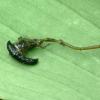
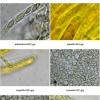
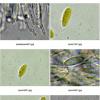
 Lindemann-2011-Sclerotinia-capillipes-0002.pdf
Lindemann-2011-Sclerotinia-capillipes-0002.pdf